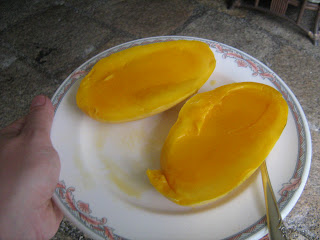
.jpg)
Wherein an adult student of oboe chronicles her adventures in music, medicine, and faith, and other stories... “Novelists, opera singers, even doctors, have in common the unique and marvelous experience of entering into the very skin of another human being. What can compare with it?” -Willa Cather

.jpg)


Let me explain about meriyenda, from the Spanish merienda, "la comida que se toma antes de la cena."
Filipinos can eat up to four or five meals a day. Breakfast (almusal), morning merienda (kind of like the hobbits' second breakfast), lunch (tanghalian), merienda, and dinner (hapunan).


Let 


 magic is over. My Tita (aunt) M, who is of Pampanga stock - and this is a Pampanga delicacy - makes THE BEST ensaymadas IN THE WORLD. Lots of people make this wondrous bread from scratch, and we've tried their versions, and they're good, even superbly yummy, but still no match for Tita M's, and once you've tried hers, you can't eat any other version and enjoy it as much. Hers are simply a culinary treasure. The 5 dozen she sent to our house on Christmas Eve are GONE. When my 7-year-old son got on the phone to ask her for more, and she asked how many she should make, he answered, "Hmm...maybe, a hundred?" She laughed her head off but said ok.
magic is over. My Tita (aunt) M, who is of Pampanga stock - and this is a Pampanga delicacy - makes THE BEST ensaymadas IN THE WORLD. Lots of people make this wondrous bread from scratch, and we've tried their versions, and they're good, even superbly yummy, but still no match for Tita M's, and once you've tried hers, you can't eat any other version and enjoy it as much. Hers are simply a culinary treasure. The 5 dozen she sent to our house on Christmas Eve are GONE. When my 7-year-old son got on the phone to ask her for more, and she asked how many she should make, he answered, "Hmm...maybe, a hundred?" She laughed her head off but said ok.
 Cylindrical wafers called barquillos. Savory treats like pancit palabok (above, middle), a noodle dish served on a large bilao, or woven basket tray, and salsa monja, an olive-and-shallot relish unknown outside the Philippines, it seems, but apparently served by Spanish nuns to Spanish friars back in the day, as a condiment to flavor their food. Yum! We also inherited merienda items from China: siomai (shrimp dumplings), siopao (steamed pork buns, below), and hopia (bean paste filled pastries, also below).
Cylindrical wafers called barquillos. Savory treats like pancit palabok (above, middle), a noodle dish served on a large bilao, or woven basket tray, and salsa monja, an olive-and-shallot relish unknown outside the Philippines, it seems, but apparently served by Spanish nuns to Spanish friars back in the day, as a condiment to flavor their food. Yum! We also inherited merienda items from China: siomai (shrimp dumplings), siopao (steamed pork buns, below), and hopia (bean paste filled pastries, also below).





 Today the hubby and I revisited Intramuros, the old walled city of Manila, and speculated on what it must have been like during colonial times. Our conclusion: sweltering! How did they survive those swishy skirts and dark suits without AC? 400 years of Spanish rule - that's a longer time under Spain than a lot of Central and South American countries had! While I'm sure the more tyrannical features of Imperial Spain stank to high heaven, I do think the disappearance of the Spanish language here is a loss...almost as bad as the deterioration of the English language today...
Today the hubby and I revisited Intramuros, the old walled city of Manila, and speculated on what it must have been like during colonial times. Our conclusion: sweltering! How did they survive those swishy skirts and dark suits without AC? 400 years of Spanish rule - that's a longer time under Spain than a lot of Central and South American countries had! While I'm sure the more tyrannical features of Imperial Spain stank to high heaven, I do think the disappearance of the Spanish language here is a loss...almost as bad as the deterioration of the English language today... of our family and a couple of priceless paintings by Filipino masters. After offering guests a tour through the house and a look at its wonderful artifacts, she offers sumptuous, five-star, table d'hôte meals from family recipes passed down by her grandmother. This has been our most memorable meal in Manila, superbly prepared, served over an exquisitely beautiful table setting, in an historic home that holds many warm memories for me, including gatherings during which we kids - one of us would grow up to be a well-loved singer, actor, and songwriter - would put on "shows" for the older folks. Now WE are the older folks! Time to step forward again to present realities! :)
of our family and a couple of priceless paintings by Filipino masters. After offering guests a tour through the house and a look at its wonderful artifacts, she offers sumptuous, five-star, table d'hôte meals from family recipes passed down by her grandmother. This has been our most memorable meal in Manila, superbly prepared, served over an exquisitely beautiful table setting, in an historic home that holds many warm memories for me, including gatherings during which we kids - one of us would grow up to be a well-loved singer, actor, and songwriter - would put on "shows" for the older folks. Now WE are the older folks! Time to step forward again to present realities! :)

*Photo of camera equipment is from www.lacocinadetitamoning.com




 We maneuvered around clusters of people to get to these vendors, our nostrils frequently assailed by the pungent stench of rotting garbage in the streets, the sweet scent of sampaguita garlands, the aroma of various foods being roasted or baked nearby, an occasional irritating whiff of cigarette smoke, and the rancid bouquet of human perspiration that was never far away. Some stands displayed a variety of oils and herbs that were supposed to have efficacy against different ailments. Others sold magic objects, or “anting-anting”:
We maneuvered around clusters of people to get to these vendors, our nostrils frequently assailed by the pungent stench of rotting garbage in the streets, the sweet scent of sampaguita garlands, the aroma of various foods being roasted or baked nearby, an occasional irritating whiff of cigarette smoke, and the rancid bouquet of human perspiration that was never far away. Some stands displayed a variety of oils and herbs that were supposed to have efficacy against different ailments. Others sold magic objects, or “anting-anting”:  amulets believed to have special powers, either to bring good fortune or to garner heavenly protection.
amulets believed to have special powers, either to bring good fortune or to garner heavenly protection. Even Nita could barely understand her.
Even Nita could barely understand her.
 It was moved to Quiapo in 1787. Quiapo church, the foundation of which was laid in 1582, went up in flames too, once in 1791 and again in 1929, but the Black Nazarene survived. The icon also survived two severe earthquakes, in 1645 and 1863, as well as the bombing of Manila in 1945. These survival stories increase the relic’s mystique and appeal among devotees, who today stood in a line which snaked around the block just to touch the statue.
It was moved to Quiapo in 1787. Quiapo church, the foundation of which was laid in 1582, went up in flames too, once in 1791 and again in 1929, but the Black Nazarene survived. The icon also survived two severe earthquakes, in 1645 and 1863, as well as the bombing of Manila in 1945. These survival stories increase the relic’s mystique and appeal among devotees, who today stood in a line which snaked around the block just to touch the statue.



 calamares en su tinta - squid in its ink - made by my mom's best friend, a Caucasian Filipina whose family is of Basque origin. We have paella here (shown above), but we also have those Asian see-through noodles and our own versions of the spring roll, fried or fresh, which we call lumpia (shown above and below). Then there's adobo, our signature dish made of chicken or pork marinated in vinegar, soy sauce, and garlic, and bagoong, our deliciously stinky condiment about which I've written before - how to explain that? I've munched on green mangoes and bagoong here like a pregnant woman with cravings - but no, I'm not pregnant, so I don't even have an excuse for the cravings.
calamares en su tinta - squid in its ink - made by my mom's best friend, a Caucasian Filipina whose family is of Basque origin. We have paella here (shown above), but we also have those Asian see-through noodles and our own versions of the spring roll, fried or fresh, which we call lumpia (shown above and below). Then there's adobo, our signature dish made of chicken or pork marinated in vinegar, soy sauce, and garlic, and bagoong, our deliciously stinky condiment about which I've written before - how to explain that? I've munched on green mangoes and bagoong here like a pregnant woman with cravings - but no, I'm not pregnant, so I don't even have an excuse for the cravings.


 most people find unusual is our purple yam, called ube. It is bright purple both raw and cooked, and as an ice cream looks as yummy as it tastes. Tonight I tried something new to me in world of ice cream: cheddar cheese ice cream. There was also a white sorbet laced with our citrus fruit, the calamansi, which produces a juice and flavor unlike that of any Western citrus fruit.
most people find unusual is our purple yam, called ube. It is bright purple both raw and cooked, and as an ice cream looks as yummy as it tastes. Tonight I tried something new to me in world of ice cream: cheddar cheese ice cream. There was also a white sorbet laced with our citrus fruit, the calamansi, which produces a juice and flavor unlike that of any Western citrus fruit.  I liked the purple ice cream best.
I liked the purple ice cream best.







